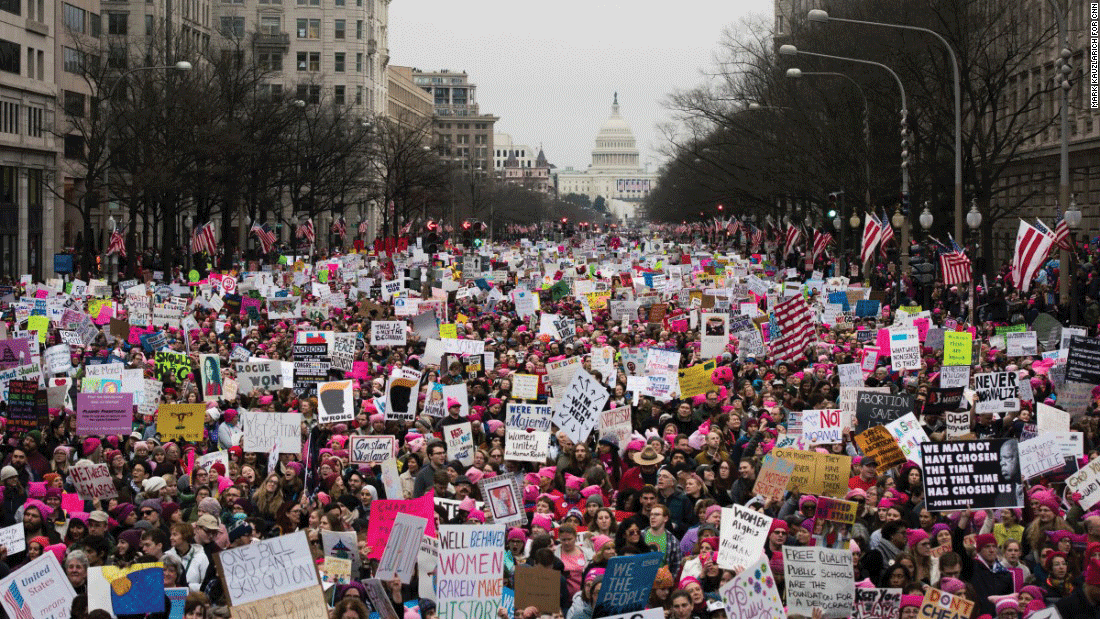Last week marked two historic events. Friday, January 20th, was the presidential inauguration of Donald Trump and Saturday, January 21st was marked by an event that was arguably just as big if not even bigger: the Women’s March on Washington.
These women — around half a million — marched together to protest the Trump agenda and defend women’s rights, civil rights, LGBTQ rights, and human rights as a whole, all of which are currently under attack from the new administration, but the march wasn’t limited to the nation’s capital alone. Women’s Marches occurred across the US and in other countries; women, men and children took to the streets, with estimates showing more than 3 million participants worldwide.
On paper, the Women’s March has done exactly what it was meant to do – unite women of all backgrounds in a display of civic strength and unity. The feeling of mutual bonding among the marchers, as well as the impact of this experience on young children, especially young girls, is no doubt incredibly important. And yet, for all the clever signs and record-shattering numbers, all the positive feminist rhetoric and excited media coverage, a small, cynical part of me can’t help but believe that it all still rings hollow.
I’ve spent a lot of time in the aftermath of the election pondering in what ways the conversation, and indeed women themselves, have changed, if they have changed at all. Some of it has been positive, but much of it has been depressingly negative. And it seems to me that most of it, regardless of where it is coming from, is merely white noise in the background of something much bigger and harder to influence. After all, merely days ago, Trump signed an incredibly restrictive anti-abortion law through executive order, and there are several more anti-abortion bills pending passage in Congress as we speak. With all due respect, I doubt the signs with “p*ssy grabs back” or other vagina-related puns/paraphernalia from the marches slowed his hand for even a moment. Sure, they make for great click-bait during a slow news day, but will they have enough of an impact to prevent them from being erased from our collective memory?
The point I’m trying to get to is this: the civic strength shown at these marches, while inspiring, will do nothing on its own. Can it turn into an organized, actionable movement, something that can actually have an effect?
This new-age feminist movement, if one can truly dub it that, risks falling into the same trap that has befallen so many of its predecessors – complacency. There comes the risk of simply being all bark and no bite. Think back to the anti-war protests prior to and after the 2003 invasion of Iraq, which took place not just on American soil but also worldwide; or the 2011 Occupy Wall Street Movement, which was started with the objective of ending Wall Street greed. In the case of the former, loud, impressive demonstrations worldwide didn’t stop the sitting administration from doing whatever they wanted. And in the case of the latter, the movement may have started with good intentions, but a lack of a cohesive agenda and a clear delineation of real, achievable policy goals caused the movement to fizzle out. The women’s movement runs the risk of falling apart the same way as those failed movements did. Right now, it suffers from a lack of a coherent agenda. There is no clear message, no clear demands. And as any woman who’s ever been in a situation that involved negotiation knows, it’s when you lose sight of your specific demands that you get talked over or simply ignored.
Infighting is also a serious concern. The women in these protests are held together by the most tenuous of threads, and as several media outlets have correctly noted, modern day feminists often forget that their feminism must be inclusive, and take into account the experience of ALL women, including minorities, LGBTQ women, disabled women, etc. Despite the organizers’ best efforts, the marchers remained, for the most part, overwhelmingly white and economically privileged. Diversity and inclusion extends beyond just race and socioeconomic status though; diversity of thought is important too, and it seems that, although politically conservative women were not stopped from marching, they were not really accepted, either. Excluding them from this conversation and relying on liberal women alone as a support base would be a huge mistake.
The marchers that day drew strength from one another, and that’s good. They need the strength to follow up with serious political organizing and action, or this inspirational march will be little more than a footnote in a history textbook. It’s an uphill battle, for sure. But it’s not impossible. To paraphrase a tweet from Michael Nutter (that was later retweeted by Hillary Clinton): Marching is good. Organizing is better. Speaking up is good. Running for office is better. Registering is good. Voting is the best.
And to paraphrase a quote from Hillary Clinton’s concession speech: Never stop believing that fighting for what’s right is worth it. But also, get a plan to make said fight a whole lot easier. Because there’s a long fight ahead of us.

Be First to Comment